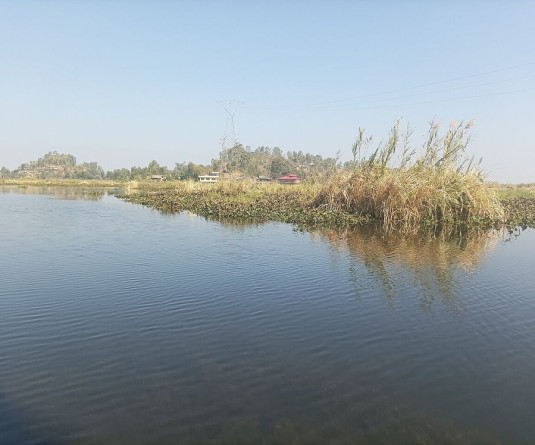
Khekiye K. Sema IAS (Rtd)
It is only when a tsunami, a hurricane or a thunder storm hits us that we realize our vulnerability against the awesome power of nature. However, this feeling of helplessness wanes with the passage of nature’s manifestation. We go back to slumber yet again, unprepared for the next calamity. This callousness has regretfully become our way of life. Forgive the boring subject that I have picked up as a consequence. Try not to go off to sleep lest lightning strikes.
Now, just look at us…even after 49+ years of Statehood we are basically no better off than when we began on the issue of self sufficiency. Every time Assam calls for a sustained economic blockade our essential commodity market goes dry. The urban population frantically scavenge the local markets and scoop up all the faction taxed rotten vegetables at an escalated price and hope that another bandh will not hit us too soon or else even the rottenest of taxed vegetables would not be available. The strain of inconvenience is common across the board, be it the common man or the better cushioned Government servants. The culinary inclination of Nagas can simply be narrowed down to rice and meat with vegetable as a trailer. By extension therefore, the Departments of Agriculture, Veterinary & Animal Husbandry has to share the dissection table of the surgeon until the ulcer of persistent market shortage and constraint is operated away and transplanted with a long term productive measures.
The Chief Minister of Nagaland had referred to the need “for suitable marketing outlets in NE” (Morung Express June 8th 2013). His view about the non-existent market network in the NE is an area that certainly deserves special attention. But along with that bigger picture, Nagaland has to achieve self sufficient production for local consumption first and can only then consider the surplus for commercial networking with the outside world. Since we are the affected party, I’d like to participate by way of sharing the modest efforts made to address the above issues of ‘production’ and ‘marketing’ during a stint as Secretary in the Department of Agriculture. It will be appreciated if this exercise is not taken as a self perpetuating effort but considers it as a brainstorming opportunity. Just pick up and strengthen what sounds workable and shoot down the rest. That is all I ask.
At present the effort of our rural farmer is limited to a production that meets kitchen requirement and an insignificant surplus for income augmentation from the local market. Beyond this any surplus would go waste for lack of marketing outlet or cold storage facility. A system strategy was therefore, structured for commercial scale production. The department focused on soil testing in each District in order to identify the best suitable crop which could be adopted by the farmers for an upscale production. Every household in the village would then get involved in the production of the adopted crop they select, besides their staple crop…paddy. This would further expand to a cluster of villages with the same focused purpose. We termed this as a Crop zoning exercise. We then concentrated on the marketing network for channelizing the produce. This resulted in the Village Marketing Committees (VMC) being set up in the crop zoned sectors followed by Agricultural Production Marketing Committees (APMC) in all the District HQs to anchor grassroots linkage. We were consciously aware that the farmers would be ill prepared to go into mass production of any commodity unless they were supplied with sufficient quality seeds. To the extent possible, proper attention was paid to procure quality seed for the selected crops. A strict caution was sent out that the farmers should ‘eat the fruits not the seed’. It was also necessary to insulate production with an assured guaranteed market. This prompted the department to consider a buy back revolving capital for the APMCs. The Department was however, unable to cater to the revolving fund scheme due to inadequate budget for this new initiative at that time. Streamlining the above policy approach into a working formation at the field level was a time consuming affair. The need to work with the season often ran into conflict in terms of timely financial investment that bureaucratic norm did not facilitate.
The Department meanwhile initiated an APMC pilot project at Kuhuboto (considering its close proximity to the commercial hub of Dimapur) to test the workability of this new scheme. 12 villages under this Sub Division were initially called in for a meeting but were subsequently opened up to all the remaining villages to participate. The existing market potential was reviewed. Each village confirmed that the surplus annual rice production in their respective villages was commercially exploited by the non-local businessmen. They would pay 30/40% of the actual cost of paddy per measuring tin in advance to the needy farmers at the start of cultivation season. They would then collect the same on harvest without additional cost. The subject of APMC and VMC was explained. After a threadbare discussion on the working mechanism, the objectives and the benefits thereof, the villager clearly understood that the farmers would stand to gain a fairer price through their VMCs/APMCs. The Department then offered to construct the APMC Office cum godown at Kuhuboto and thereafter proposed that each village purchase Rs.50,000/- per share to build up the revolving fund for the APMC (which would consist of one member representative from each member village). This fund would be disbursed by the APMC to the needy farmers at a fairer price through the Village Marketing Committee as a buy back advance. Despite their initial skepticism they finally settled for Rs.30,000/- per share. Some villages bought more than one share and an approximate amount of Rs.5,00,000/- was ultimately raised as a revolving capital. The VMCs clamped down on advance funding by non-local businessmen in their respective villages. Ikuto the then SDAO Dimapur was given strict instruction to assist and supervise the functioning of the APMC and he did a commendable job. With the help of the department, SBI loan for tractor and trailer was also arranged for the APMC the following year. This eased the transportation of pledged paddy after harvest from VMC to the APMC godown. They had starting hiccups but Kuhuboto APMC gradually increased the revolving fund capital to a little over one crore rupees in course of time. The new strategy initiative had worked. Replication was now a possibility.
Under the wings of Agriculture Department, NEPED also actively went into serious market study and coordinated ginger production through the crop zoning approach and for the very first time helped the farmers to export approximately 350 ton of ginger to Subji mandi, New Delhi. Positive signs of possibilities were beginning to emerge. Project proposal based on our strategy, was approved and funded by Ministry of Agriculture, GOI. The Department constructed APMC Office cum godowns in most of the District HQs in active coordination with the APMC members. Armed with results so far accrued, a more concerted effort was made to convince the State Government to provide a special budget for effective operationalization of the buyback revolving fund for the APMC. The then Development Commissioner, Alemtemshi Jamir (present Chief Secretary), perceived the potentiality and went out of the way to scavenge Rs. 20 lakhs as a start up fund against our projected requirement of one crore. By now, I had already done close to 3 years stint in the Department and was transferred out. It saddened me to learn later that this revolving fund so vital for the success of the APMC was subsequently allocated haphazardly, more on political inclination rather than target productive potentiality. The initiatives of setting up APMCs and VMCs network; the important focus on soil testing, crop zoning, buy back revolving funds should have gained reasonable maturity by now unless abandoned after my departure from the Department which frequently happens in a Government system. While the above mentioned strategy was aimed at commercial production, it could be modulated to focus on local market requirement in a more fluent sustained manner by strengthening the APMCs and VMCs in the neighborhood of the District HQs at least. It would make sense to revive the earlier tested effort if alternative initiative is not envisioned.
Going back in time as Additional Deputy Commissioner, at Kiphire 1983, we had delved into the subject matter of V&AH sector. While touring the area, we came across a small village named Keor with approximately 37 households. We saw a fairly large abandoned pig sty. This village seemed to have had an inherent interest in pig rearing. They had been making an effort to rear community pigs but ran into management problems. They therefore divided the community pigs to individual households who would be responsible to house and feed the pigs free of cost. When the community pigs littered, they evolved a unique system of sharing the piglets between the rearer and the community at a ratio of 3:1 with the larger share going to the rearer. They confidently confided that this system worked perfectly well for them with the incentive package. We decided to try out their system on a larger scale. So, through the SDPB fund we procured a dozen matured sows and two boars from the Government farm and had them distributed as VDB community pigs to the better off households in Keor. Like anywhere else, the boar itself was naturally unproductive in terms of littering, even in Kiphire. The rearer would therefore receive a piglet from every sow it successfully crossed. The male pig owner would meticulous keep a ‘when it did it’; ‘with which sow it did it’ kind of account because piglets would have to be collected at a later stage. Within the year there were a sizable number of community VDB piglets. The boars had done a good active job. This village was adopted as a piggery project village with a clearance to supply piglets to other VDB villages with piggery intent. On the second year the Department of V&HA Kiphire was sent to the village to vaccinate the community pigs at Keor, as a precautionary health coverage for the animals. The consequence of their effort was devastating…they successfully wiped out the community pigs in this village. Only the naughty pigs which had escaped the vaccination drive survived. A report was dispatched to the Director, V& AH with a request that the Department make good the losses, in kind. Thanks to the Director, this was done and promptly too. The invitation for the department to study the VDB community management approach at Keor Village for replication as a Departmental programme was however, not responded to. Perhaps they should consider it now, instead of complacently importing cadaver and carcass eating pigs from Bihar and other Indian cities.
It would be wonderful if the Department of Agriculture and Veterinary & Animal Husbandry do some serious brainstorming, prioritize key issues and introduce innovative production chain in their respective sectors to at least meet local market needs consistently. Overcoming the dependency cult would be a worthy exercise and a welcomed change. We could then laugh at Assam bandh.




